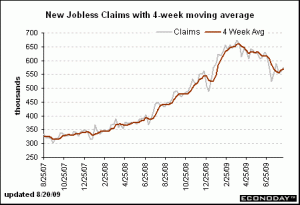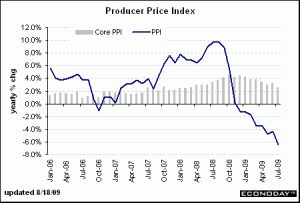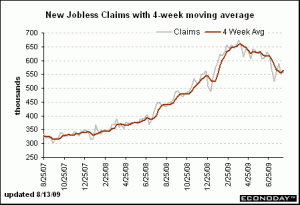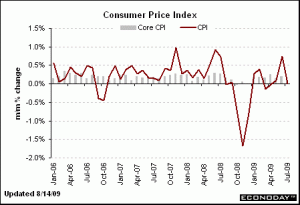Market Commentary: August 25th, 2009: 9:00 am (PST). Posted by Manu Walia
“The consumer confidence report shows improvement across nearly all components in a plus that ends two months of prior disappointment. The consumer confidence index rose nearly 7 points in August to 54.1 vs. July’s 47.4 (46.6 first reported). Strength is centered in expectations components led by the assessment of future business conditions and the assessment of employment.”
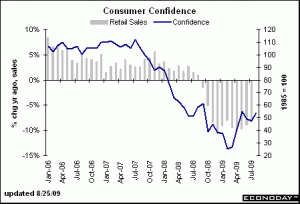
Once again, the consumer confidence is a gauge of how hopeful a sample pool of individuals are about the future economic conditions of our country. On one hand, we have high unemployment and federal debt, and on the other hand we have the rise in capital markets. In our opinion, we believe that investors start to wrap themselves with a blanket of false sense of security as their assets (stocks, bonds and real estate) start to inflate.
As mentioned in our previous commentaries, average investors which include retail and institutions, continue to follow the trend till the trend reverses. We believe that the crescendo of investors pouring assets in to the markets in hoards has yet to develop. At that point we may see the markets spike up to a new high and then correct by as much as 5-10%. We believe that the fair value of the S&P 500 is around 1050-1100 (currently trading at 1035), using 2010 earnings estimates. Again, investor action can overshoot on the upside just like we overshot on the downside in March, 2009.
We would be in the favor of being cautious as the markets continue to rise. We would continue to raise cash at 1050-1100 levels to take advantage of interim 5-7% corrections in the market.
Market Commentary: August 20th, 2009: 9:00 am (PST). Posted by Manu Walia
“Jobless claims data are a disappointment, showing increases in both initial claims and continuing claims. Initial claims for the Aug. 15 week rose 15,000 to 576,000 with the Aug. 8 week revised 3,000 higher.”
“The index of leading economic indicators is pointing to recovery. The LEI rose 0.6 percent in July boosted by rising long rates, the prior dip in initial jobless claims, and the rise in the factory workweek.”
Despite the somewhat negative news on the unemployment data, the markets have not reacted negatively. These types of numbers would have decimated the markets during the later half of 2008 and early this year. On the other hand, the overall macro analysis of economic variables would indicate that we are in a recovery and therefore, most investors are compelling themselves to only concentrate on the positives.
We do not believe that the markets move up or down in a straight line, but the trend seems to be in a bullish phase. The reason stems not from just economic data but the basic human need to be optimistic. History shows that over the long term, the markets have moved forward and not backwards, just like human progress. We will not indulge in a debate over moral vs. capitalistic progress as we are focusing on the material world.
We believe that the recent rise in the market value still leaves room for growth as a lot of investors that have been left behind are waiting to enter the markets and will at some point succumb to greed and start investing. This self fulfilling prophesy is a move towards another bubble in our view. We wish that we had the expertise to predict the area of this projected bubble, but then again, we wouldn’t be in the business of providing advice.
Market Commentary: August 18th, 2009: 9:00 am (PST). Posted by Manu Walia
“Inflation at the producer level in July declined sharply on both declines in food and energy. And the core rate was nudged down by lower prices for light trucks. The overall PPI dropped 0.9 percent after spiking 1.8 percent in June. The decline in July was greater the market forecast for a 0.3 percent dip in the headline PPI.”
“Homebuilding in July slipped from June’s gain but remained above recent lows. Also, the single-family component continued its uptrend. Housing starts in July decreased 1.0 percent, following a 6.5 percent boost the month before.”
It can be observed from the recent economic indicators that the US and global economy is showing signs of revival. With an exception of unemployment, most economic indicators have improved. The major broad based indexes are also showing confidence and have since moved to higher levels.
We have mentioned that we expect intermediate corrections while the markets moves into a bull phase. The last two days markets lost approximately 2-3%. This may only be a blip in the big scheme of things and may not seem significant. On the other hand some company stocks lost anywhere from 12-17% despite announcing robust earnings.
We therefore, believe that a prudent way of investing currently would be to build positions in areas of growth using the dollar cost averaging methodology. As mentioned in our previous commentaries, we believe that Financials, Industrials, Technology and Materials will be the areas that will attract investors as these sectors are the main beneficiaries of government bailouts and global growth.
Market Commentary: August 11th, 2009: 12:30 am (PST). Posted by Manu Walia
Dt. August 13th, 2009:“The rate of layoffs is heavy but steady as first-time jobless claims were little changed in the Aug. 8 week, at 558,000 vs. 554,000 in the prior week. The numbers, in a plus, are a little bit below the four-week average, which is at 565,000.”
Chart Source: www.Bloomberg.com
Dt. August 14, 2009:“In July, consumer price inflation eased on lower gasoline prices while the core slowed on a rare dip in shelter costs.”
Dt. August 14, 2009:“Industrial production in July added to the argument that the recession is over, rebounding primarily on motor vehicle assemblies. Overall industrial production in July jumped 0.5 percent, following a revised 0.4 percent decline in June. The July boost came in just under the market expectation for a 0.6 percent gain. The manufacturing component posted a 1.0 percent increase after contracting 0.6 percent in June.”
It can be observed that major economic indicators have started to move in the positive direction. Even though the consumer sentiment declined a bit, the overall economic direction if this country seems to be headed in the right direction.
After a robust run up in the major broad based indexes, we believe that there could be an interim correction of 5-7%. The markets may be in a bull phase, but investors always find a way to take profits. As mentioned umpteen times in the past, markets do not move up or down in a straight line. We would be investors at any pullbacks as we believe that over the next 2-3 years the markets could provide healthy returns. Also, specific sectors could provide superior performance. We would be in the camp of investing in Financials, Technology, Industrials and Materials.
Market Commentary: August 11th, 2009: 12:30 am (PST). Posted by Manu Walia
Following is an excerpt from our July 30th Market Commentary.
“…We believe that there is a chance that the indexes may overshoot on the upside similarly they over shot on the downside. Our prediction is that there will be short term corrections of 5-7% while we move forward. Currently, we would be inclined to harvest profits and wait for a pull back before allocating further capital to the market…”
There is a lot of noise in the short term which is attributable to market fluctuations; in other words we know that investor psychology vacillates between fear and greed. Because the volatility of the recent past is fresh in every ones mind, it’s natural for investors to be cautious. More importantly, the sentiment to err on the side of taking profits as opposed to wait and watch becomes dominant when the major indexes gain more than normal returns in a short time horizon. This can be observed by the gain in the Dow Jones Industrial Index which has been approximately 15% in a span of 3 weeks or since July 10th.
We believe that the markets do correct 5-7% intermittently within a secular bull phase. Our belief in the long term bullish projection is predicated on the assumption that the economy has actually turned around and most investors are in the mode to view news more positively than negatively. As the second quarter corporate earnings wind down, investors are comfortable with higher revenue and earnings projections. This could be the self fulfilling prophesy that continues to lift markets to a level that overshoots fair value on the indexes and move into a bloated and overbought conditions.
In the meantime, we would recommend that investors be ready to start investing or adding to their investments at approximately 5-6% below current index levels. Alternatively, investors worried about excessive trading could hedge their portfolios prudently with funds that short major broad based indexes and protect to a certain extent on the downside.
Source: www.bigcharts.com
Market Commentary: August 6th, 2009: 11:00 am (PST). Posted by Manu Walia
“Initial jobless claims fell 38,000 to a much better-than-expected level of 550,000 (prior week revised 4,000 higher to 588,000). Very importantly, there were no special factors in the week. The current level is right at the four-week average of 555,250, more than 50,000 lower than the average at June’s end.”
We have been emphasizing the employment situation since early June. We believe that the employment variable has a direct impact on the housing markets in addition to the US domestic consumption which comprises of over 70% of the US economy.
We have been of the thought that the unemployment will peak at around the 10%. Our inferences were based on the layoffs relating to the US housing and construction, automobile sector and the slowdown in the industrial industry due to global economic slowdown. We feel that worldwide stimulus packages have instilled confidence since fourth quarter 2008, and will boost investments in particularly the industrial and technology sector. This phenomenon in my view will allow bolster employment and hopefully help increase productivity. It would be important to increase productivity or else we would face inflationary consequences.
In the interim, the jobless situation seems to be improving illustrated in the chart below. Despite the improving employment economic conditions, we would caution investors to gradually increase their investment capital during market pullbacks or in other words, interim corrections of 3-5%.
Chart Source: www.Bloomberg.com
Market Commentary: August 5th, 2009: 12:00 pm (PST). Posted by Manu Walia
“ADP’s private payroll count shows substantial improvement as expected, at -371,000 for July vs. a revised -463,000 in June. The result, the best since October last year, confirms expectations for improvement in Friday’s jobs report.”
Despite the recent improvement in the economic fundamentals and the current employment report from the private payroll count from ADP, the market is in the mode to take profits. As we have mentioned before, human psychology vacillates from one extreme of the sentiment to the other. We believe that even though the market sentiment has changed for the better, there will be interim pull backs in the market as the recent market turmoil was too severe and too recent to forget.
In addition, markets have never and will never move up or down in a straight line. We believe that the prevailing magnitude of fluctuations will be large enough to benefit from active management of one’s portfolio. This doesn’t mean that one should trade like a fiend but at the same token be willing to take more than normal gains and position to re-enter at lower levels.
Chart Source: www.Bloomberg.com
Market Commentary: July 31st, 2009: 10:00 am (PST). Posted by Manu Walia
“The economy is coming closer to the end of recession based on the advance estimate for second quarter GDP. The economy contracted in the second quarter by only 1.0 percent, following a revised 6.4 percent drop in the first quarter.” Source: www.Bloomberg.com
 The mother of all variables is the development in the overall economy. It is obvious from the readings on the chart below that the last quarter GDP decelerated at a much slower rate relatively. This is great news for investors so why did the market react tepidly. As I write this, the Dow Jones Industrial Average (9.52 am, PST) is trading in the positive by 6 points. In other words the actual deceleration in the economy was almost half of what was expected by most economist and financial pundits.
The mother of all variables is the development in the overall economy. It is obvious from the readings on the chart below that the last quarter GDP decelerated at a much slower rate relatively. This is great news for investors so why did the market react tepidly. As I write this, the Dow Jones Industrial Average (9.52 am, PST) is trading in the positive by 6 points. In other words the actual deceleration in the economy was almost half of what was expected by most economist and financial pundits.
Chart Source: www.Bloomberg.com
I believe that most of the recovery for 2009 is factored in the market. As mentioned in our previous commentary, we believe that the earnings growth has been factored into the markets and the S&P 500’s fair value (factoring earnings growth expectation) should be in the range of 1050-1100. This could mean that the markets could gain another 10-12 %. On the flip side, the fact remains that the markets have gained almost 14% over the last 3 weeks or 15 trading days. That is too much too quick in our view. We believe that the markets can pull back in the short term. Investors with a longer horizon who are willing to withstand interim corrections should do well. In the short term we would be harvesting profits to raise cash for better entry point.
DISCLAIMER:
The data and analysis contained herein are provided “as is” and without warranty of any kind, either expressed or implied. Continuum Global Asset Management LLC (CGAM), any CGAM affiliates or employees, or any third party data provider, shall not have any liability for any loss sustained by anyone who has relied on the information contained in any CGAM publication. All opinions expressed herein are subject to change without notice, and you should always obtain current information and perform due diligence before trading. CGAM accounts that CGAM or its affiliated companies manage, or their respective shareholders, directors, officers and/or employees, may have long or short positions in the securities discussed herein and may purchase or sell such securities without notice. CGAM uses and has historically used various methods to evaluate investments which may, at times, produce contradictory recommendations with respect to the same securities. When evaluating the results of prior CGAM recommendations or CGAM performance rankings, one should also consider that CGAM may modify the methods it uses to evaluate investment opportunities from time to time, that model results do not impute or show the compounded adverse effect of transaction costs or management fees or reflect actual investment results, that other less successful recommendations made by CGAM are not included with these model performance reports, that some model results do not reflect actual historical recommendations, and that investment models are necessarily constructed with the benefit of hindsight. For this and for many other reasons, the performance of CGAM’s past recommendations and model results are not a guarantee of future results. The securities mentioned in this document may not be eligible for sale in some states or countries, nor be suitable for all types of investors; their value and income they produce may fluctuate and/or be adversely affected by exchange rates, interest rates or other factors. All of the views expressed in CGAM research reports accurately reflect the research analyst’s personal views regarding any and all of the subject securities or issuers. No part of any analyst compensation was, is, or will be, directly or indirectly, related to the specific recommendations or views expressed in a research report. Further distribution prohibited without prior permission. Copyright 2009 © Continuum Global Asset Management LLC. All rights reserved.

